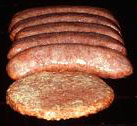
Prepared by
Melissa Brener, MS
Page 3 of 4
Vitamin C is mainly found in citrus
fruits such as oranges, lemons and grapefruits. It is also present
in potatoes, tomatoes and green vegetables. Fresh fruits and
vegetables are the best sources of vitamin C because cooking
and processing these foods destroy the vitamin. The RDA for vitamin
C is 60 mg/day.
|
|
Click here for the printable (Word) version of the lesson
The Water-Soluble Vitamins
There are two water-soluble vitamins - the vitamin B complex
and vitamin C. Because these are water-soluble, they can be dissolved
in the cellular fluid. Therefore, excess amounts are easily removed
from the body in the urine. When foods containing water-soluble
vitamins are cooked, they tend to lose many of these vitamins
due to high cooking temperatures and the process of cooking in
water. Cooking vegetables in small amounts of water helps to
limit the amounts of vitamins lost.
The B Vitamins
Thiamin
 Thiamin is found in meat (especially
pork), dairy foods, fortified grain products, green beans, peanuts,
other beans and seeds. White bread is fortified with thiamin
and is the major dietary source in the United States. A thiamin
deficiency causes the disease beriberi. Before white bread was
fortified with thiamin, this disease was a widespread problem
in the U.S. because signs of deficiency begin after less than
two weeks of a thiamin-free diet. Symptoms of beriberi include
weakness, tingling, irritability, muscle pain and loss of appetite.
Currently, the elderly and alcoholics are the two populations
most at risk for a thiamin deficiency. Elderly people often eat
more highly processed foods, which have lost most of their thiamin
during processing. Alcoholics have a harder time absorbing thiamin
into their bodies. Thiamin is found in meat (especially
pork), dairy foods, fortified grain products, green beans, peanuts,
other beans and seeds. White bread is fortified with thiamin
and is the major dietary source in the United States. A thiamin
deficiency causes the disease beriberi. Before white bread was
fortified with thiamin, this disease was a widespread problem
in the U.S. because signs of deficiency begin after less than
two weeks of a thiamin-free diet. Symptoms of beriberi include
weakness, tingling, irritability, muscle pain and loss of appetite.
Currently, the elderly and alcoholics are the two populations
most at risk for a thiamin deficiency. Elderly people often eat
more highly processed foods, which have lost most of their thiamin
during processing. Alcoholics have a harder time absorbing thiamin
into their bodies.
Riboflavin
Riboflavin aids the body's cells in producing the energy needed
to live and grow. A lack of riboflavin in the diet causes the
disease ariboflavinosis. The symptoms of this disease include
an inflamed mouth and tongue, nervous symptom disorders and mental
confusion.
Good sources of riboflavin are leafy green vegetables, mushrooms,
liver and other meats, dairy products and enriched grain products.
Niacin
Niacin is part of several vital cellular pathways. It plays
a part in the production of energy and helps make fatty acids
(parts of fats) among other things. A lack of niacin in the diet
causes the deficiency disease pellagra. Pellagra means rough,
painful skin - the first symptom of the disease. Pellagra first
causes dermatitis, which is worsened by the sun. If left untreated,
it can cause diarrhea, dementia and finally death. Because white
breads are enriched with niacin (along with thiamin and riboflavin),
pellagra is no longer a problem in the United States. Too much
niacin in the diet (over 100 milligrams per day) can cause increased
blood flow to the skin, creating a flushed appearance. Other
symptoms include headaches and itching.
Pantothenic Acid
Pantothenic acid is a very common vitamin. In fact, a deficiency
is very rare because pantothenic acid is found in so many foods.
Symptoms of a deficiency are dermatitis and neuromuscular disorders.
Pantothenic acid is involved in many pathways that work in the
body. Foods that are especially good sources of pantothenic acid
include eggs, liver, yeast, peanuts and milk.
Biotin
Biotin can be found in several foods or can be made in the
body. Egg yolks, liver, cheese, peanuts and yeast are all good
sources of biotin. Most people are not at risk for a biotin deficiency.
Rarely, however, infants can be born with low levels of the enzyme
needed to make biotin in the body. This can lead to a deficiency.
Symptoms of a biotin deficiency include dermatitis and hair loss.
Vitamin B6
This vitamin, also known as pyridoxine, is involved in many
body processes. Some people have claimed that vitamin B6 is helpful
in treating premenstrual syndrome (PMS) in women. This claim
has not been proved though.
 Vitamin B6 can be found in many
fruits and vegetables, such as broccoli, cantaloupe, bananas
and spinach. Meat, fish and poultry are also good sources. A
vitamin B6 deficiency is found most often in alcoholics because
alcohol affects the structure of vitamin B6. The RDA for vitamin
B6 is 2.0 milligrams per day for men and 1.6 milligrams per day
for women. Vitamin B6 levels can easily become toxic if too much
is consumed. Toxicity symptoms include numbness of the extremities
and permanent nerve damage. Vitamin B6 can be found in many
fruits and vegetables, such as broccoli, cantaloupe, bananas
and spinach. Meat, fish and poultry are also good sources. A
vitamin B6 deficiency is found most often in alcoholics because
alcohol affects the structure of vitamin B6. The RDA for vitamin
B6 is 2.0 milligrams per day for men and 1.6 milligrams per day
for women. Vitamin B6 levels can easily become toxic if too much
is consumed. Toxicity symptoms include numbness of the extremities
and permanent nerve damage.
Folate
Folate, also known as folacin or folic acid, is a very important
vitamin, especially for women who are pregnant or of child-bearing
age. If a pregnant woman does not consume enough folate in her
diet or has a folate deficiency, her child could be born with
a neural tube defect such as spina bifida or anencephaly (absence
of a brain). If a person has a folate deficiency, they usually
have a type of anemia known as megaloblastic anemia. This means
that the red blood cells cannot mature and divide to make new
cells. Therefore, they grow very large and fragile. Pregnant
women, alcoholics and people taking certain medications have
the biggest risk of folate deficiency.
There are several good food sources of folate. These include
breakfast cereals that have been fortified with folate, leafy
green vegetables, melons, oranges, strawberries, liver, eggs
and beans. Fresh fruits and vegetables are better sources than
processed, canned or cooked ones because these processes destroy
part of the folate. The RDA for folate is 180-200 micrograms
per day for adults. However, women of child-bearing age should
eat 400 micrograms per day to prevent birth defects.
Vitamin B12
One of the functions of vitamin B12 is to help the body use
folate. A deficiency of vitamin B12 can cause a type of anemia
known as pernicious anemia. Because vitamin B12 and folate deficiencies
both cause anemia, it is sometimes difficult to tell which one
a person is deficient in. Food sources of vitamin B12 include
meat, poultry, seafood, eggs and organ meats. Milk products also
contain vitamin B12. Because the best sources of vitamin B12
are animal foods, people who are strict vegetarians should make
sure they consume vitamin B12 from other sources. These can include
soy products, fortified cereals and vitamin supplements. The
RDA for vitamin B12 is 2 micrograms per day for adults.
Vitamin C
 Vitamin C, also called ascorbic
acid, is absorbed from the food in the small intestine. If a
person eats between 30-120 milligrams per day of vitamin C (the
RDA is 60 milligrams per day), the body uses 80-90% of this vitamin
C. However, if a person consumes larger amounts, the body uses
a much lower percentage and excretes the rest in the urine. Excess
vitamin C can also cause diarrhea. Vitamin C, also called ascorbic
acid, is absorbed from the food in the small intestine. If a
person eats between 30-120 milligrams per day of vitamin C (the
RDA is 60 milligrams per day), the body uses 80-90% of this vitamin
C. However, if a person consumes larger amounts, the body uses
a much lower percentage and excretes the rest in the urine. Excess
vitamin C can also cause diarrhea.
Vitamin C has several functions. One is to make collage, a
protein used by the body in connective tissue. Vitamin C also
helps the body absorb and use iron more efficiently. Therefore,
if a person is anemic, they should consume more vitamin C in
addition to more iron. Vitamin C is also an antioxidant, so it
protects the body from free radicals.
If a person has a vitamin C deficiency, they may develop a
disease called scurvy. Scurvy causes the connective tissue in
the body to change. This results in weakness and small hemorrhages
around the hair follicles that are visible on the surface of
the skin. The gums and joints also bleed.
Vitamin C is mainly found in citrus fruits such as oranges,
lemons and grapefruits. It is also present in potatoes, tomatoes
and green vegetables. Fresh fruits and vegetables are the best
sources of vitamin C because cooking and processing these foods
destroy the vitamin. The RDA for vitamin C is 60 milligrams per
day.
   [ LESSONS || SITE
MAP || LOCAL AGENTS || RESOURCES || PEOPLE ]
[ LESSONS || SITE
MAP || LOCAL AGENTS || RESOURCES || PEOPLE ]
 Issued in furtherance of Cooperative Extension
work, Acts of Congress of May 8 and June 30, 1914, in cooperation with the United States
Department of Agriculture. The Louisiana Cooperative Extension Service provides equal
opportunities in programs and employment. Information and Graphics on this site are
copyright protected by LSU Agricultural Center's Louisiana Cooperative Extension Services. For more information on the EFNEP program, contact EFNEPMail@agcenter.lsu.edu. Issued in furtherance of Cooperative Extension
work, Acts of Congress of May 8 and June 30, 1914, in cooperation with the United States
Department of Agriculture. The Louisiana Cooperative Extension Service provides equal
opportunities in programs and employment. Information and Graphics on this site are
copyright protected by LSU Agricultural Center's Louisiana Cooperative Extension Services. For more information on the EFNEP program, contact EFNEPMail@agcenter.lsu.edu.
|